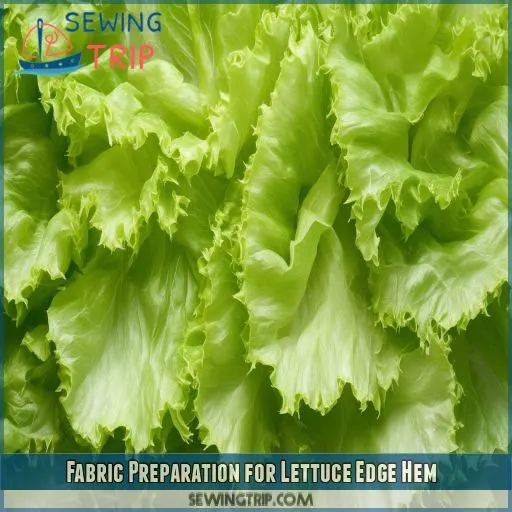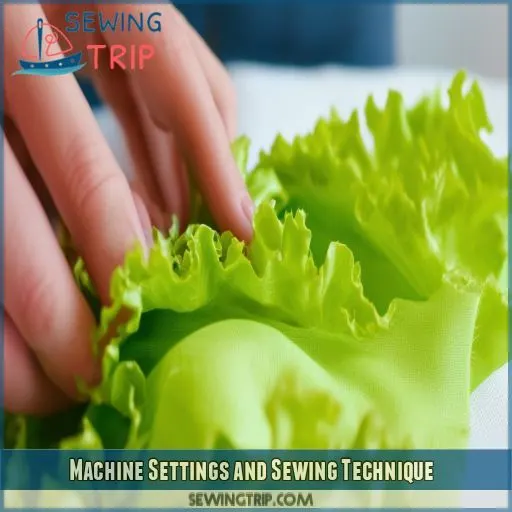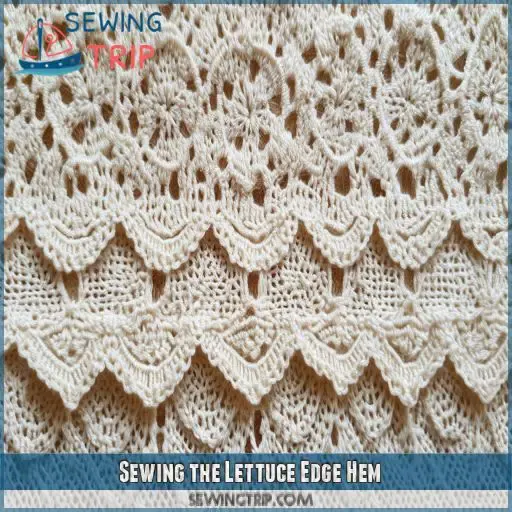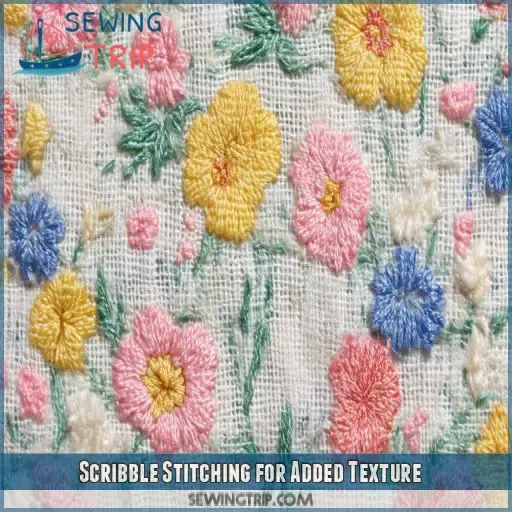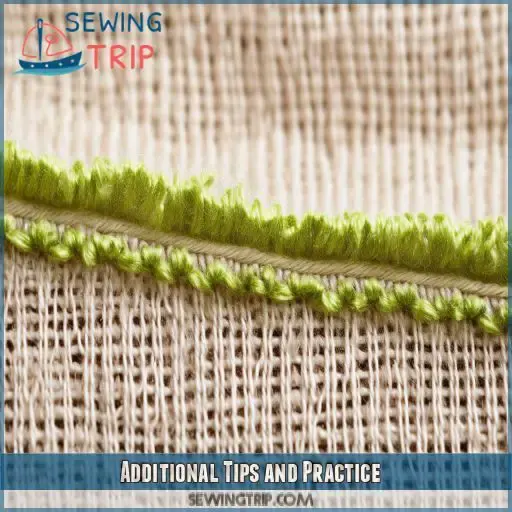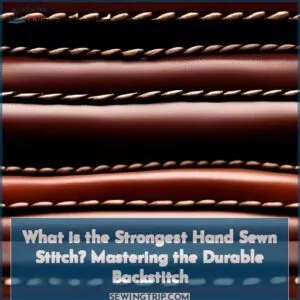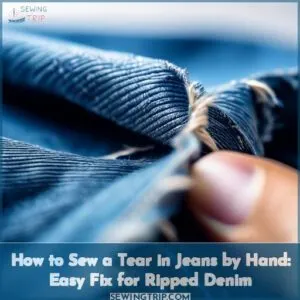This site is supported by our readers. We may earn a commission, at no cost to you, if you purchase through links.
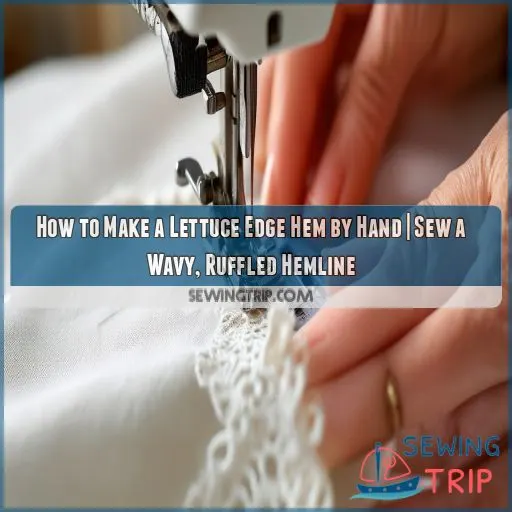 Unlock ruffled chic with a lettuce edge hem, crafted by your hands. This sewing technique transforms stretchy fabrics into wavy, flowing hems. Elevate skirts, dresses, and sleeves with captivating texture. Embrace creative expression as you manipulate fabric, mastering precise stitching and controlled stretching. Indulge your desire for innovation by experimenting with various knits, unveiling gorgeous lettuce edged garments uniquely yours.
Unlock ruffled chic with a lettuce edge hem, crafted by your hands. This sewing technique transforms stretchy fabrics into wavy, flowing hems. Elevate skirts, dresses, and sleeves with captivating texture. Embrace creative expression as you manipulate fabric, mastering precise stitching and controlled stretching. Indulge your desire for innovation by experimenting with various knits, unveiling gorgeous lettuce edged garments uniquely yours.
Table Of Contents
Key Takeaways
- Determine the fabric’s stretch direction and curl pattern to guide the hand sewing technique.
- Use a short, wide zigzag stitch to secure the rolled fabric edge while stretching the fabric.
- Adjust thread tension, needle size, and presser foot pressure to achieve the desired wavy hemline effect.
- Experiment with different stitch lengths and patterns, such as scribble stitching, to add visual texture to the lettuce hem.
How to Make a Lettuce Edge Hem by Hand ?
To sew a lettuce edge hem by hand, first fold the fabric edge over by about 1/8 inch and pin it in place. Then, using a zigzag stitch, stretch the fabric as you sew to create a wavy, ruffled hemline that resembles the edge of a lettuce leaf.
The key is to stretch the fabric as you sew the zigzag stitches, which will cause the hem to ruffle and create the lettuce-like appearance once the fabric relaxes.
Fabric Preparation for Lettuce Edge Hem
To prepare the fabric for a lettuce edge hem, you need to determine the fabric’s stretch direction and curl direction.
Stretch the fabric to identify the curl direction, as this will be the top layer when sewing.
Cut a small fabric sample for testing purposes before proceeding with your project.
This will help you get the right machine settings and ensure a successful hem.
Determining Fabric Stretch Direction
To determine the fabric stretch direction for a lettuce edge hem, follow these steps:
- Fold the fabric: Lay the fabric flat on a table or a clean surface. Fold it in half along the grain line, which is the direction in which the fabric stretches most easily. The grain line is usually indicated by the selvage, the finished edge of the fabric that runs parallel to the warp threads.
- Hold the fabric: With one hand, hold down the fabric that’s near the 0” mark on the ruler, ensuring it doesn’t move. With the other hand, take the cut edge or selvedge edge near the 10” mark and gently tug on it.
- Stretch the fabric: Pull the fabric to see how far it will stretch without overstretching. The fabric should stretch easily, but not too far. If the fabric stretches from 10” to 13”, for example, it has a 30% stretch in this direction.
- Determine the stretch percentage: Calculate the percentage of stretch by dividing the amount the fabric stretches by the starting length and then multiplying by 100. For example, if the fabric stretches from 10” to 13”, the stretch percentage would be (3/10) x 100 = 30%.
- Check both directions: Repeat the process for the cross grain, which is perpendicular to the grain line. This will help you determine the direction of greatest stretch (DOGS), which is typically important in patterns and pattern piece placement.
Identifying Curl Direction
To identify the curl direction of your fabric, you’ll need to stretch it gently in different directions.
This will help you determine which way the fabric curls when you apply tension.
Once you’ve identified these, you can cut a fabric sample for testing.
This process is crucial for creating a lettuce edge hem with a wavy finish.
Cutting Fabric Sample
To prepare your fabric for a lettuce edge hem, it’s crucial to cut a fabric sample for testing.
Start by determining the fabric’s stretch direction and curl direction.
Then, cut a small piece of the fabric, ensuring it’s the same weight as the rest of the fabric.
This sample will help you practice sewing techniques and adjust your machine settings for the best results.
Machine Settings and Sewing Technique
You’ll need to tweak your machine’s settings to perfect that wavy, ruffled hemline. Set your stitch length short and your width wide, then keep that presser foot aimed right at the fabric’s roll.
Adjusting Stitch Length and Width
To create a lettuce edge hem, you’ll need to adjust your sewing machine’s stitch settings. Here are three key aspects to consider:
- Stitch length: A shorter stitch length, such as 0.3, is recommended for a lettuce edge hem. This allows the stitches to be close together and creates a smooth, wavy edge.
- Stitch width: A wider stitch width, like 5.0, is suitable for this type of hem. This wider setting helps to cover more fabric and creates a more pronounced wavy effect.
- Thread selection: Choose a matching thread for your fabric to ensure a seamless finish.
When sewing the hem, aim the presser foot at the fabric roll and pull the fabric at the front and back while sewing. Stretch the fabric and roll it under the presser foot to create a wavy hemline. Once finished, allow the fabric to regain its shape, which will cause the edge to curl and create the characteristic lettuce edge effect.
For decorative stitching, such as scribble stitching, you can experiment with different stitch settings to achieve various textures. Remember to always test your stitch settings on scrap fabric before working on your project to ensure the best results.
Positioning Presser Foot
Positioning the presser foot is crucial for the success of your sewing project, especially when working with stretchy fabrics like those used for the lettuce edge hem. The presser foot plays a vital role in guiding the fabric as you sew, ensuring that the stitches are even and the fabric isn’t stretched or puckered. Here are some tips for positioning the presser foot correctly:
- Adjust the bobbin thread tension: Make sure the bobbin thread tension is appropriate for the fabric you’re working with. A tighter bobbin thread tension will help prevent the fabric from bunching up under the presser foot.
- Stitch perpendicular to the grain line: When working with knit fabrics, it’s essential to stitch perpendicular to the grain line to avoid stretching the fabric.
- Stretch the fabric as needed: As you sew, gently stretch the fabric in front of the presser foot to help maintain the correct tension.
- Use a rolled hem presser foot: If you’re working on a curly hem, a rolled hem presser foot can help guide the fabric and ensure that the stitches are evenly spaced.
- Adjust the presser foot pressure: If you’re experiencing skipped stitches or uneven stitching, adjust the presser foot pressure to ensure that the fabric is correctly fed through the machine.
Guiding and Stretching Fabric
To create a lettuce edge hem, you’ll need to guide and stretch your fabric while sewing.
Start by pulling the fabric at the front and back as you sew.
While also stretching it and rolling it under the presser foot.
Use a wide, short zigzag stitch to secure the fabric roll.
Experiment with different fabric thicknesses, like jeans adjusters or old clothes, to find what works best for your project.
Sewing the Lettuce Edge Hem
To sew a lettuce edge hem by hand, you’ll need to follow these steps:
-
Fabric Preparation:
- Determine the fabric’s stretch direction by stretching it and observing which way it curls.
- Cut a small sample of the fabric to test the machine settings and stitching technique.
-
Machine Settings:
- Adjust the stitch length to a short zigzag stitch, typically around 0.3.
- Set the stitch width to a wider setting, such as 5.0.
- Ensure the presser foot is positioned correctly and aimed at the fabric roll.
-
Sewing Technique:
- Pull the fabric at the front and back while sewing to stretch it and cause it to roll under the presser foot.
- Sew a wide, short zigzag stitch over the fabric roll to create the wavy hemline.
- Once the fabric has regained its shape, the close stitching on the edge will force the edge to curve and curl back and forth in a pretty wave.
-
Finishing Touches:
- Allow the fabric to regain its shape after sewing.
- The close stitching forces the edge to curve and curl, creating a wavy hemline.
-
Scribble Stitching:
- Use a straight stitch with a length of 2 to 3 for added texture.
- Stitch across the fabric in wavy lines, without stretching the fabric.
- Guide the fabric in long curving lines and turn and stitch back the way you came, loosely following your path.
-
Practice and Experimentation:
- Practice on different fabrics to understand their behavior and adjust your technique accordingly.
- Experiment with different stitch lengths and widths to find the best results.
- Try out the scribble stitching for added texture and visual interest.
Pulling Fabric During Sewing
As you sew your lettuce edge hem, it’s like taming a wild yarn.
Pull the fabric taut, front and back, feeling its stretch, guiding it under the presser foot.
Your stitch length is your rhythm; keep that bobbin full to avoid mid-seam mishaps.
Imagine turning thrift store finds into a caterpillar outfit masterpiece.
Or reviving a favorite top with a fresh hem repair.
Keep it snappy and creative!
Creating the Wavy Hemline
Creating the wavy hemline is an artful process that involves sewing the lettuce edge hem with precision.
Start by setting your sewing machine to a zigzag stitch with a width of 5 and a length of 1.5.
Position the presser foot a few millimeters from the edge of the fabric. Pull the fabric gently as you sew, allowing it to curl naturally.
Adjust the thread tension and needle size for optimal results. The presser foot pressure should be just enough to guide the fabric without causing it to bunch or pucker.
As you sew, the fabric will curl, creating a beautiful, ruffled hemline.
Finishing Touches
To achieve the perfect lettuce edge hem, you’ll need to pay meticulous attention to the finishing touches.
Begin by ensuring your fabric stretches correctly.
Then adjust your stitch settings to create the desired wave effect.
Experiment with different trial fabrics to find the right balance between stretch and stitch length.
The process of navigating the complexities of this technique is part of the journey towards mastering this bespoke, tailored hemline.
Scribble Stitching for Added Texture
To create a lettuce edge hem by hand, you can use the scribble stitching technique.
This method involves setting a straight stitch length of 2 to 3, guiding the fabric in wavy lines, and stitching across the fabric in a zigzag pattern.
Unlike the lettuce edge hem technique, which uses a zigzag stitch to create a ruffled effect, scribble stitching doesn’t stretch the fabric.
Instead, it allows you to create a unique texture on the fabric.
To experiment with scribble stitching, you can try different stitch lengths and widths, as well as change the thread color for added visual interest.
Setting Straight Stitch Length
To set the straight stitch length for scribble stitching, aim for a length of 2 to 3.
As you stitch across the fabric in wavy lines, guide the fabric in long curving lines.
Don’t stretch the fabric, but keep your bobbin full for a smooth stitching experience.
This technique adds texture and visual interest to your projects.
Experiment with different fabrics and thread colors to unlock the full potential of your sewing machine.
Guiding Fabric in Wavy Lines
After setting your stitch length, you’re ready to dive into the art of guiding fabric in wavy lines. Think of it as doodling with thread; let your hands dance freely across the fabric, creating loops and swirls as you go. This isn’t just sewing; it’s unleashing your creativity on a canvas of cloth. Remember, perfection is overrated; embrace the waves!
Experimenting With Scribble Stitching
Experimenting with scribble stitching can add texture to your lettuce edge hem.
To try this technique, set your stitch length to 2 to 3 and stitch across the fabric in wavy lines.
Don’t stretch the fabric, but guide it in long curving lines.
Turn and stitch back the way you came, loosely following your path.
This method works best on stretchy fabric types, so be sure to navigate the curl direction carefully.
Loose stitches are key to creating a wavy, ruffled effect.
Additional Tips and Practice
To make a lettuce edge hem by hand, there are several additional tips and practices to consider. First, ensure that you have a full bobbin of thread to work with. This will give you plenty of thread to work with and prevent any interruptions in your sewing process.
Next, practice on different fabrics to get a feel for how the fabric behaves when sewing a lettuce edge hem. Some fabrics may require different stitch lengths and widths, so experimenting with different settings on your sewing machine can help you achieve the desired result.
Finally, changing the thread to add visual interest is another way to enhance your lettuce edge hem. Using a contrasting or complementary thread color can create a unique and eye-catching effect.
Ensuring a Full Bobbin
To ensure a full bobbin when sewing a lettuce edge hem, follow these tips:
- Bobbin size: Choose a bobbin size that’s appropriate for your sewing machine. Most machines come with a standard bobbin size, but it’s essential to use the correct one for your specific machine.
- Thread quality: Use high-quality thread that’s suitable for your fabric and sewing machine. Low-quality thread can break easily, leading to uneven stitching and potential bobbin issues.
- Tension settings: Adjust the tension settings on your sewing machine to ensure the thread is taut and even. This will help prevent wavy seams and ensure the bobbin is used efficiently.
- Bobbin winding technique: Wind the bobbin carefully, ensuring that the thread isn’t stretched or twisted. This will help prevent thread breakage and ensure the bobbin is full.
- Bobbin storage: Store your bobbins in a dry, dust-free environment. This will help prevent the thread from deteriorating and ensure the bobbins are ready to use when needed.
By following these tips, you can ensure that your bobbin is always full and ready to use when sewing a lettuce edge hem.
Practicing on Different Fabrics
To practice creating a lettuce edge hem, you can experiment with different fabrics to understand their stretch directions and curl identification. Start by cutting fabric samples from various types of stretch fabrics, such as knit jersey, spandex, or lycra. These fabrics will have different stretch properties, so it’s essential to understand how they behave when cut and sewn.
Once you have your fabric samples, you can adjust your machine settings to match the fabric’s stretch. For example, you might use a zigzag stitch with a width of 4 and a stitch length of 1 for a thinner, more flexible fabric, while a thicker, less stretchy fabric may require a different stitch length and width.
As you sew, be mindful of the fabric’s curl direction. Some fabrics may curl more than others, so you’ll need to adjust your technique accordingly. For example, you might need to pull the fabric more gently or adjust the presser foot to accommodate the fabric’s curl.
To create a lettuce edge hem, you’ll want to sew right on the edge of the fabric and pull gently to stretch as you sew. Guide the fabric from the back with your left hand and stretch it in front with your right hand. The cut edge of the jersey will probably curl a bit, but that’s okay. Just keep experimenting and you’ll get the hang of it.
You can also try out different stitching techniques, such as the scribble stitch, to add texture and interest to your hems. Remember to practice on different fabrics and adjust your machine settings and sewing technique as needed to achieve the desired results.
Changing Thread for Visual Interest
Switching up your thread can turn your sewing project from meh to wow! Think of your thread as the spice in your sewing recipe. Mixing colors, shades, and even textures adds depth and personality. Don’t shy away from bold patterns or contrasting hues. It’s like giving your fabric a voice, and trust me, it wants to sing.
Frequently Asked Questions (FAQs)
How do I prevent the fabric from stretching unevenly?
To prevent uneven stretching, keep a steady, gentle pull on the fabric as you sew. Use your hands to evenly distribute the tension across the entire edge. This’ll give you a smooth, consistent lettuce hem every time.
Can I use a serger instead of a regular sewing machine?
Yes, you can totally use a serger for the lettuce edge hem! Its differential feed helps evenly gather stretchy fabrics, creating uniform curling.
What type of thread works best for a lettuce edge?
Use all-purpose polyester thread for your lettuce edge hem. Its strength and stretchiness help create that delightfully ruffled, curled look. Cotton thread works too, but may break when heavily stretched.
How do I finish the raw edge after sewing the lettuce hem?
Zigzagging over the raw edge catches threads, preventing unraveling. Hold fabric taut; let it naturally gather as you stitch. Clip excess for a flawlessly frilly finish!
Can I add decorative elements to the lettuce edge?
Absolutely! You can jazz up your lettuce edge by weaving in contrasting threads, ribbons or even thin strips of fabric. Get creative with colors and textures for a playful, personalized touch.
Conclusion
Every crease holds creative potential; you’ve unlocked the gateway to wavy, textured hems. Revel in your newfound mastery over lettuce edge techniques, letting fabric stretch and curl under your skilled hands. With practice, you’ll confidently sew captivating garments, each stitch a testament to your ingenuity. Embrace the joy of handcrafting unique pieces that exude ruffled chic.

